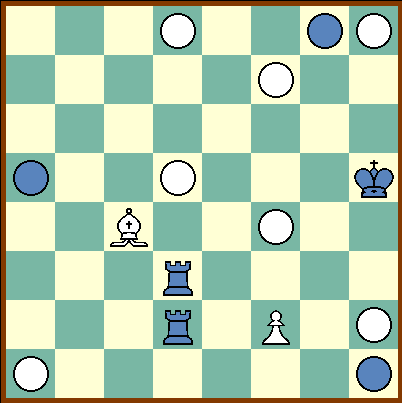Piececlopedia: Orphan
Historical notes
The Orphan was invented by David L. Brown in the early 1970s.Brown, who is a problemist, invented the Orphan for the purpose of using it in chess problems, for which it is very well suited. Brown's book, White and Black from Brown - A Selection of 168 Diagrams and Chess Related Fluff, contains many problems using the Orphan. One of Brown's Orphan demonstration problems appears below.
The standard symbol for the Orphan in problem diagrams is a circle.
Movement
The Orphan is a dummy unit that has no movement powers of its own. Rather, it has the power to move like any enemy piece that is attacking it. If the attacking piece or the Orphan moves away, or another piece intervenes, the Orphan loses the power it had gained from that piece. Orphans can gain powers from more than one piece, and can also gain powers from other Orphans, setting off chain reactions if enough Orphans are positioned right. According to Brown, an Orphan threatened by a Rook can not be used to castle, and an Orphan threatened by a Pawn can not promote or capture en passant. An Orphan can move next to an enemy King, checking it.Movement diagram
In the diagram below, the Orphan on c4 has the power of both Knight (attacking the Orphan from e5) and Bishop (attacking from f1), and hence can move to any of the squares marked by a small red circle; it can also capture the Bishop or Knight. If the Knight were to move to d3, the Orphan would become immobile, since neither piece would be attacking the Orphan.

In the diagram below, the black King is checkmated. If you're not sure why, an explanation is given below the diagram.

The white Orphan on d5 is attacked by the black Rook on d3, therefore
it gives check to the black King. Actually, it gives doublecheck,
since it attacks the black Orphan on a5, who in turn attacks the white
Orphan on a1, who attacks the black Orphan on h1, who attacks the
white Orphan on h2, who also checks the black King.
The black King has no squares it can move to, note that it can not
move to g4, because it would then attack the Orphan on f4, which would
check the black King.
Black can not play R:d5. If he did, the Rook would now attack the white
Orphan on d8. This would set up a new Orphan chain, d8-g8-h8, which
would check the black King. Therefore, R:d5 is illegal.
Likewise, Black can not play O(a5):d5 either. The black Orphan on d5 is
now attacked by the white Bishop on c4, which give Bishop power to the
white Orphan on f7, checking the black King.
And of course, moving the Rook on d3 along the third rank does not work,
since the Rook on d2 would then attack the Orphan on d5. Therefore,
Black has no way to get out of check, and is checkmated.
Problem
Below is a problem composed by David L. Brown as a demonstration of the Orphan. It originally appeared in the Orphan's introductory article in British Chess Magazine, and was reproduced in Brown's book Black and White from Brown. You can read the solution and Brown's comments here. The problem is a helpmate in 2, which means that white and black are cooperating the achieve checkmate in 2 moves.
British Chess Magazine, 1972
h#2

Remarks
The Orphan has not been used in any game thus far; it is probably a very weak piece, since it can easily be stranded by its enemies.The Orphan's complimentary piece is the Friend, also invented by David Brown.
David Howe discusses the Orphan and Friend in a broader context in his article on Mimics.
Torsten Linss has three published problems using the Orphan, which he has online here.
This is an item in the Piececlopedia: an overview of different (fairy) chess pieces.
Written by Benjamin C Good.
WWW page created: September 9, 1998.